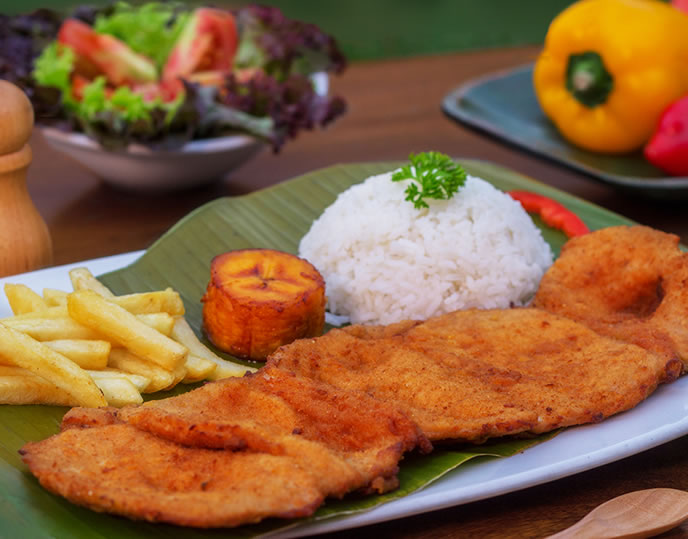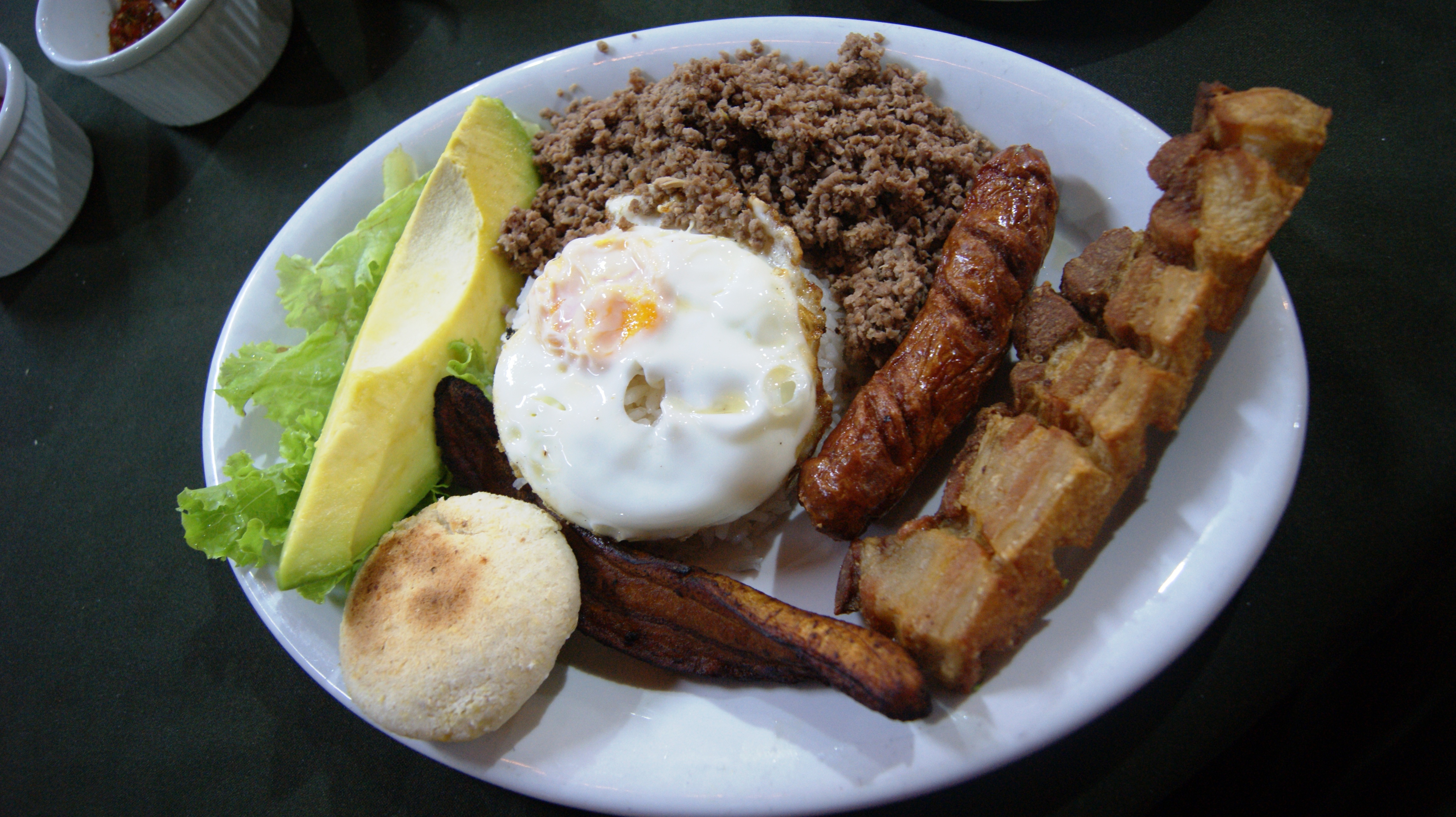|
Calentado
Calentao', sometimes spelled calenta'o (Colombian Spanish creole folk slang for "heated," derived from the Standard Spanish word ''calentado'') is a Paisa and Antioquia, Colombian cuisine dish made from reheated leftovers including rice, egg, pasta, beans, potatoes and other foods such as arepa, chorizo, and ground beef. It is generally eaten for breakfast and is often accompanied by aguapanela, arepa, coffee, juice or hot chocolate. Depending on the region it can also be served with hogao. It is sometimes referred to as Fríjoles Trasnochaos. A fried egg is usually served on top of the dish and it is called Calentao' "A Caballo" . It is usually eaten for breakfast using some of the night before's leftovers.Calentado July 6, 2009 My Colombian Recipes See also * |
Plantain (cooking)
Cooking bananas are banana cultivars in the genus ''Musa'' whose fruits are generally used in cooking. They may be eaten ripe or unripe and are generally starchy. Many cooking bananas are referred to as plantains (/ˈplæntɪn/, /plænˈteɪn/, /ˈplɑːntɪn/) or green bananas. In botanical usage, the term "plantain" is used only for true plantains, while other starchy cultivars used for cooking are called "cooking bananas". True plantains are cultivars belonging to the AAB group, while cooking bananas are any cultivars belonging to List of banana cultivars, AAB, AAA, ABB, or BBB groups. The currently accepted scientific name for all such cultivars in these groups is Musa × paradisiaca, ''Musa'' × ''paradisiaca''. Fe'i bananas (''Musa'' × ''troglodytarum'') from the Pacific Islands are often eaten roasted or boiled, and are thus informally referred to as "mountain plantains," but they do not belong to any of the species from which all modern banana cultivars are descended. ... [...More Info...] [...Related Items...] OR: [Wikipedia] [Google] [Baidu] |
Arepa
''Arepa'' () is a type of food made of ground maize dough stuffed with a filling, eaten in the northern region of South America since pre-Columbian times, and notable primarily in the cuisine of Colombia and Venezuela, but also present in the cuisines of Bolivia, Panama and other countries. It is commonly eaten in those countries and can be served with accompaniments such as cheese, ''cuajada'' (fresh cheese), various meats, chicken, avocado, or ''diablito'' (deviled ham spread). It can also be split to make sandwiches. Sizes, maize types, and added ingredients vary its preparation. It is similar to the Mexican ''gordita,'' the Salvadoran ''pupusa'', the Ecuadorian ''tortilla de maíz'' and the Panamanian ''tortilla'' or ''changa''. Origins The ''arepa'' is a pre-Columbian dish from the area that is now Colombia, Panama and Venezuela. Instruments used to make flour for the ''arepas'', and the clay slabs on which they were cooked, were often found at archaeological sites in the a ... [...More Info...] [...Related Items...] OR: [Wikipedia] [Google] [Baidu] |
Breakfast
Breakfast is the first meal of the day usually eaten in the morning. The word in English refers to breaking the fasting period of the previous night.Anderson, Heather Arndt (2013)''Breakfast: A History'' AltaMira Press. Various "typical" or "traditional" breakfast menus exist, with food choices varying by regions and traditions worldwide. History The English word "dinner" (from Old French ) also referred originally to breaking a fast; until its meaning shifted in the mid-13th century it was the name given to the first meal of the day. The tradition of eating a morning meal has existed since ancient times, though it was not until the 15th century that "breakfast" came into use in written English as a calque of dinner to describe a morning meal: literally a breaking of the fasting period of the night just ended. In Old English the term had been , literally "morning food." Ancient breakfast Ancient Egypt In Ancient Egypt, peasants ate a daily meal, most likely in the morning, ... [...More Info...] [...Related Items...] OR: [Wikipedia] [Google] [Baidu] |
Paisa Region
A Paisa is someone from a region in the northwest of Colombia, including part of the West and Central ''cordilleras'' of the Andes in Colombia. The Paisa region is formed by the departments of Antioquia, Caldas, Risaralda and Quindío. Some regions of Valle del Cauca Department (north) and Tolima Department (west) culturally identify as ''paisas''. The main cities of the Paisa region are Medellín, Pereira, Manizales and Armenia. The name Paisa derives from the Spanish apocope of ''Paisano'' (countryman), but they are also known as "Antioqueños" (those from the old Antioquia, which included the other Paisa provinces, which was a single administrative body until the creation of the Caldas State in 1905). Although many refer to Paisas as an ethnic group (''raza antioqueña'' or ''raza paisa''), they are a part of the Colombians and Latin American peoples. Paisas can be found in other regions of Colombia and the Americas where they have migrated. They have such a pa ... [...More Info...] [...Related Items...] OR: [Wikipedia] [Google] [Baidu] |
Antioquia Department
) , anthem = Himno de Antioquia , image_map = Antioquia in Colombia (mainland).svg , map_alt = , map_caption = Antioquia shown in red , image_map1 = Antioquia Topographic 2.png , map_caption1 = Topography of the department , coordinates = , subdivision_type = Country , subdivision_name = , subdivision_type1 = Region , subdivision_name1 = Andean Region , established_title = Established , established_date = 1826 , founder = , named_for = , seat_type = Capital , seat = Medellín , parts_type = Largest city , parts_style = para , p1 = , government_footnotes ... [...More Info...] [...Related Items...] OR: [Wikipedia] [Google] [Baidu] |
Colombia
Colombia (, ; ), officially the Republic of Colombia, is a country in South America with insular regions in North America—near Nicaragua's Caribbean coast—as well as in the Pacific Ocean. The Colombian mainland is bordered by the Caribbean Sea to the north, Venezuela to the east and northeast, Brazil to the southeast, Ecuador and Peru to the south and southwest, the Pacific Ocean to the west, and Panama to the northwest. Colombia is divided into 32 departments and the Capital District of Bogotá, the country's largest city. It covers an area of 1,141,748 square kilometers (440,831 sq mi), and has a population of 52 million. Colombia's cultural heritage—including language, religion, cuisine, and art—reflects its history as a Spanish colony, fusing cultural elements brought by immigration from Europe and the Middle East, with those brought by enslaved Africans, as well as with those of the various Amerindian civilizations that predate colonization. Spanish is th ... [...More Info...] [...Related Items...] OR: [Wikipedia] [Google] [Baidu] |
Colombian Cuisine
Colombian cuisine is a compound of the culinary traditions of the six main regions within Colombia (Pacific, Amazonian, Andean, Orinoco, Caribbean, and Insular). Colombian cuisine varies regionally and is particularly influenced by Indigenous Colombian, Spanish, and African cuisines, with slight Arab influence in some regions. Furthermore, being one of the most biodiverse countries in the world, Colombia has one of the widest variety of available ingredients depending on the region. History of Colombian food Colombian food is a unique blend of indigenous and European traditions with a strong Afro-Caribbean influence. The two largest indigenous groups prior to European conquest were the Tairona, who lived along the Caribbean coast, and the Muisca, who lived in the highlands to the South. Arepas, made from ground corn, are one of the oldest cooked dishes in Colombian cuisine. It is believed that the name derives from the word for corn in the Chibcha languages. Arepas are a popul ... [...More Info...] [...Related Items...] OR: [Wikipedia] [Google] [Baidu] |
Aguapanela
Aguapanela, '' agua de panela'' or ''agüepanela'' is a drink commonly found throughout South America and a few parts of Central America and Caribbean. Its literal translation means "panela water" as it is an infusion made from panela which is derived from hardened sugar cane juice. Though recipe variations exist throughout South America, it is most popular in Colombia. In Colombia, it is commonly drunk with a hint of lemon, much the way tea is consumed. Preparation Aguapanela is made by adding pieces of panela to water and stirring until the pieces are entirely dissolved. The drink may be served hot or cold, with lemon or lime often being added. In the hot form, sometimes milk or a chunk of cheese is added in place of fruit juice. In Colombia, black coffee is often prepared with aguapanela instead of water and sugar. In Costa Rica, panela is combined with hot water or milk to make ''agua dulce'' ("sweet water"), a common breakfast drink. Uses Many claims have been made about t ... [...More Info...] [...Related Items...] OR: [Wikipedia] [Google] [Baidu] |
Hogao
Hogao is a variant of Spanish sofrito and is typically used in Colombian cuisine. Traditionally made with only long green onions and tomatoes, differing from guiso, which can also be made with round onions, garlic, cumin, salt, and pepper that are sauteed over low heat during the cooking process. It is used for meats, arepas, rice, and other dishes, and can complement the famous ''bandeja paisa''. The ingredients and naming tradition varies from region to region, though it is originally from Antioquia and the region whose people are known as paisa. Its name comes from the old use of the verbs ''ahogar'' and ''rehogar'' that reference a slow cooking technique. Goya Foods Goya Foods, Inc. is an American producer of a brand of foods sold in the United States and many Spanish-speaking countries. It has facilities in the United States, Puerto Rico, the Dominican Republic and Spain. It is under third-generation ownersh ... sells bottled hogao commercially in the United States. Re ... [...More Info...] [...Related Items...] OR: [Wikipedia] [Google] [Baidu] |
Bandeja Paisa
''Bandeja paisa'' (Paisa refers to a person from the Paisa Region and bandeja is Spanish for platter), with variations known as ''bandeja de arriero'', ''bandeja montañera'', or ''bandeja antioqueña'', is one of the most representative meals in Colombian cuisine, especially of the Antioquia Department, Antioquia department and the Paisa Region A Paisa is someone from a region in the northwest of Colombia, including part of the West and Central ''cordilleras'' of the Andes in Colombia. The Paisa region is formed by the departments of Antioquia, Caldas, Risaralda and Quindío. S ..., as well as with the Colombian Coffee-Growers Axis (the departments of Caldas Department, Caldas, Quindío Department, Quindío and Risaralda Department, Risaralda), and part of Valle del Cauca Department, Valle del Cauca and the northwest of Tolima Department, Tolima. The main characteristic of this dish is the generous amount and variety of food in a traditional ''bandeja paisa'': Kidne ... [...More Info...] [...Related Items...] OR: [Wikipedia] [Google] [Baidu] |
Sancocho
Sancocho (from the Spanish verb ''sancochar'', "to parboil") is a traditional soup in several Latin American cuisines. Variations represent popular national dishes in Dominican Republic, Colombia, Cuba, Honduras, Ecuador, Panama, Puerto Rico, Trinidad and Tobago, and Venezuela. It usually consists of large pieces of meat, tubers and vegetables served in a broth. Variations In Puerto Rico, sancocho is considered a fairly rustic dish. It is made with chicken and smoked ham (sancocho de gallina), top round beef (sancocho), pork feet with chickpeas (sancocho de patitas), beef short ribs with chorizo, or fish, shellfish and salted cod cooked in coconut milk and ginger with rice dumplings (caldo santo). There are several versions and every household has their own take on sancocho, but a true Puerto Rican sancocho always calls for corn on the cob, a variety of tubers, squash, green bananas, and meat. The hearty stew is served with a small bowl of rice, pique criollo, tostones, and ... [...More Info...] [...Related Items...] OR: [Wikipedia] [Google] [Baidu] |
_and_one_loose_plantain.jpg)

.jpg)

